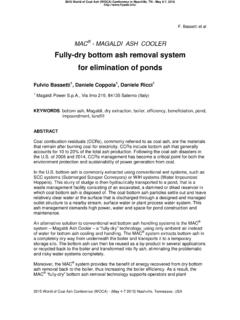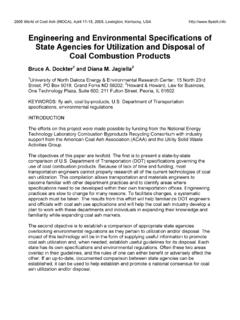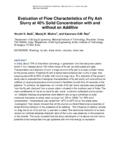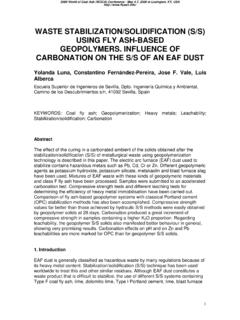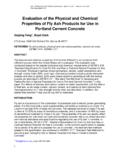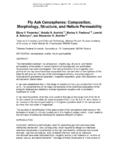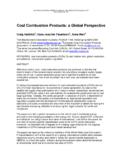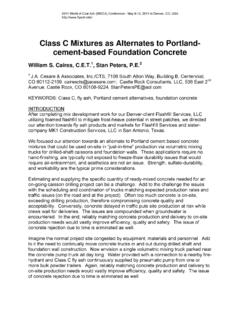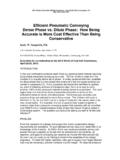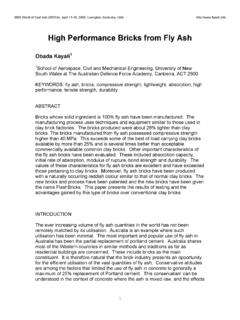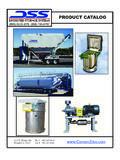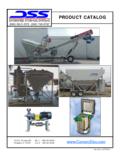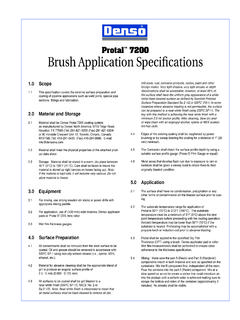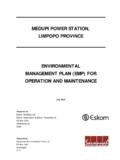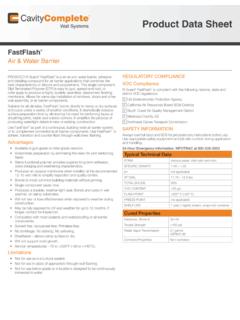Transcription of Hydraulic Conductivity of Compacted Cement …
1 Hydraulic Conductivity of Compacted Cement - stabilized Fly Ash Michael E. Kalinski1 and Praveen K. Yerra1 1 University of Kentucky, Department of Civil Engineering, 161 Raymond Building, Lexington, Kentucky 40506-0281 KEYWORDS: fly ash, portland Cement , compaction, Hydraulic Conductivity BACKGROUND Ash is produced from the combustion of coal at a global rate of approximately 480 million metric tons per year1. This includes bottom ash and flue gas desulfurization (FGD) material, but about two thirds of the ash is in the form of airborne particles, also known as fly ash.
2 Fly ash is a fine-grained, dusty material that consists of SiO2, Al2O3, CaO (quicklime), and other minor constituents, and is primarily produced by electric power plants. Due to its abundance, it is advantageous for fly ash producers to identify practical uses for fly ash rather than dispose of it in landfills at a significant cost. Numerous uses have been identified for fly ash in construction, including soil stabilization and portland Cement supplementation2. Fly ash usage is also gaining in popularity in the agriculture industry for the construction of high-strength cattle feedlot pads3.
3 In the European Union, over 90% of coal combustion byproducts (CCBs), including fly ash, are recycled1. In other parts of the world, a much smaller percentage of fly ash (for instance, about one quarter in the United States) is utilized, with the remaining fly ash disposed in landfills2. Clearly, there is significant room for improvement with respect to utilizing fly ash, and it is of benefit to identify uses in which fly ash is the primary constituent, rather than an additive, to accelerate its consumption. Class F fly ash is a product of the combustion of older, harder bituminous and anthracite coal.
4 In contrast, class C fly ash is a product of the combustion of younger lignite and sub-bituminous. Class F fly ash contains less than 10% quicklime, while class C fly ash contains more than 10% quicklime. Since this study was conducted using fly ash from coal mined in the Appalachian region of the United States, class F fly ash was used. With relatively little quicklime, class F fly ash is not self-cementing, and a cementing agent, such as portland Cement , quicklime, or hydrated lime (CaOH2), must be added. When combined with a cementing agent, hydrated, and Compacted , class F fly ash forms a high-strength material with unconfined compressive strength as high as 5,500 kPa3.
5 This material possesses numerous potential uses for construction, including embankments, highway base courses, and cattle feedlot pads. 12005 World of Coal Ash (WOCA), April 11-15, 2005, Lexington, Kentucky, combustion byproducts have also been used as low-permeability Hydraulic barriers in a manner similar to Compacted clay. Wolfe et demonstrated the use of Compacted FGD material for the construction of low-permeability liners for animal waste lagoons. In their research, FGD material was mixed with fly ash and Compacted to form a Hydraulic barrier at the bottom of the lagoon.
6 Hydraulic Conductivity (k) ranging from x 10-5 to x 10-8 cm/s was measured in laboratory specimens prepared using standard proctor compaction effort (ASTM D698), while large-scale field measurements yielded steady state k around x 10-7 cm/s. Ghosh and Subbarao5 also demonstrated that fly ash, when combined with hydrated lime and Compacted using standard proctor effort, possesses k on the order of x 10-5 cm/s. They further demonstrated that k decreases with increasing hydrated lime content and increasing water content (w), and that with the addition of around 1% gypsum (CaSO4 2 H2O), k can be reduced to around x 10-7 cm/s.
7 With respect to the x 10-7 cm/s criterion commonly prescribed in regulations for Compacted clay liners (CCLs) for waste containment, these results indicate that, in some instances, Compacted CCBs, including Compacted fly ash, may perform satisfactorily. These studies also demonstrated that the water quality of the effluent permeating through these materials is not significantly impacted by the CCB, and that acceptable water quality standards are achievable. Like Compacted clay, the dry density of Compacted fly ash varies with water content. Dry density, d, is defined as: VMsd= , (1) where Ms is the mass of dry solids in a volume V.
8 Water content, w, is defined as: %xMMwsw100=, (2) where Mw is the mass of water. For a given compaction effort, the relationship between d and w, referred to as a compaction curve, is a concave-downward plot of d versus w, with a maximum dry density, dmax, at a corresponding optimum water content, wopt. Ghosh and Subbarao5 demonstrated that k of Compacted fly ash is less when compacting wet of wopt, and recommend that w be wet of wopt to minimize k. Similar observations have been made for Compacted clay by Mitchell et They demonstrated that k decreases by several orders of magnitude when going from dry of wopt to wet of wopt, and that k less than x 10-7 cm/s can be achieved when wet of wopt.
9 Daniel and Benson7 developed an acceptance window approach to specifying d and w for Compacted clay to minimize k by combining two or more compaction curves generated at different compaction efforts. By compacting within an acceptance window that includes the locus of points wet of wopt, k will be low. This approach can be expanded by measuring k of each Compacted specimen, superimposing constant k 2contours over the compaction curves, and delineating an acceptance window that satisfy a desired k criterion ( k < x 10-7 cm/s). This approach is particularly attractive because it eliminates the requirement that the field compaction effort be equivalent to a specific laboratory compaction effort.
10 As mentioned previously, fly ash Compacted with portland Cement is currently being used as a construction material for livestock feedlot pads due to its strength and durability3. To provide information for the analysis of surface water and infiltration rates for this material, accurate estimate of k is required. Therefore, the study detailed herein was performed to measure k of this material using various Cement contents, water contents, and compaction efforts. Another purpose of this study was to elaborate on existing research regarding the Hydraulic characteristics of Compacted fly ash- Cement mixtures to develop relationships between d, w, and k in a manner similar to the approach used for Compacted clay.
